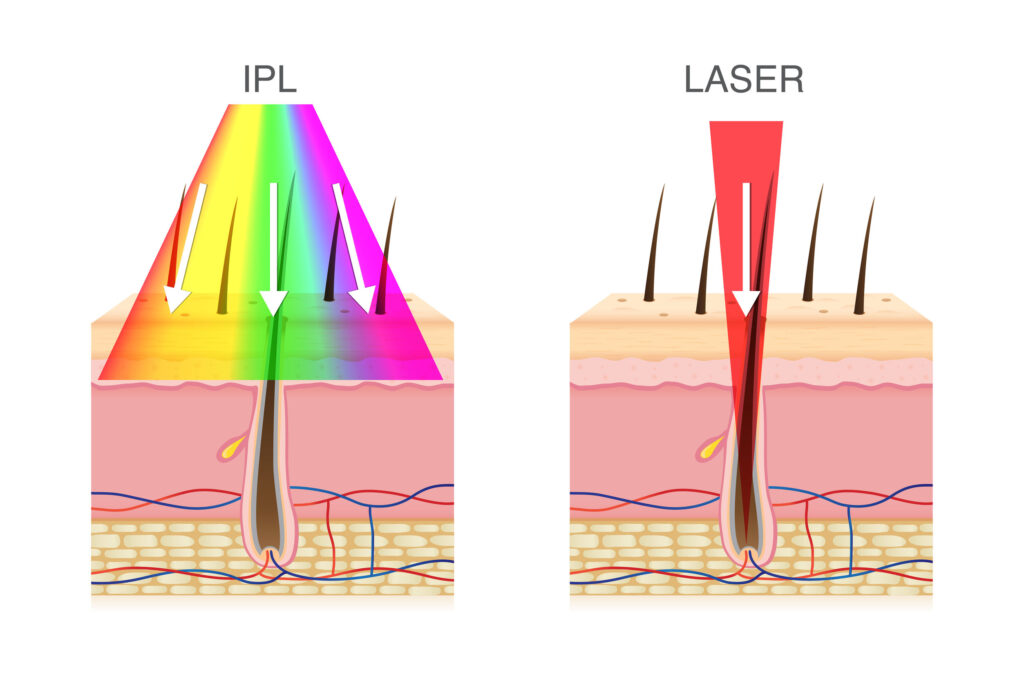It’s difficult to separate fact from fiction when it comes to hair removal especially when you search for information online and consistently run into conflicting thoughts that contradict each other.
Here are 5 things you may have heard or read about that you shouldn’t believe when it comes to hair removal.
All Lasers Work For Hair Removal
Laser hair removal really didn’t come into vogue until around 1997 when the FDA began approving commercial clinic-grade laser hair removal machines for hair removal.
In actuality, the FDA previously cleared a product called SoftLight by ThermoLase for hair removal and the company made claims that couldn’t be substantiated (painless, permanent hair removal). Several years and many lawsuits later the product was withdrawn from service.
Moral of the story? Don’t believe everything you read or hear. Here are two examples of lasers you may hear about for hair removal that you should avoid:
Argon Laser: Was used beginning in the 1970s for various skin services such as tattoo removal and for ingrown eyelashes. It began being touted by some as a hair removal option. But it uses a very short 488 nm wavelength and is thus not suitable for hair removal.
Currently by way of comparison, the Nd:YAG laser hair removal machine which can serve all skin types I-VI uses a wavelength of 1064 nm.
Ruby Laser: The oldest laser hair removal technology. While it was once the only game in town, there really isn’t a reason to use this laser technology for hair removal anymore. You’ll generally see the newest laser removal technologies incorporating multiple laser types like Nd:YAG, Alexandrite and/or IPL. Ruby is not included as it’s no longer needed.
With a 694 nm wavelength it’s much lower than what the Nd:YAG or even the Diode laser offers. You’ll find it more difficult to find a Ruby laser practitioner and these days, why bother when there are better options?

Laser and IPL Offer Permanent Hair Removal
They don’t. The FDA has approved electrolysis for permanent hair removal but that’s it. Certain laser and IPL products have been approved for permanent hair reduction and can offer long term reduction of significant amounts of hair but you really need to temper your expectations.
Both processes do tend to require multiple treatments, on a schedule over time, and are only suitable for certain hair colors and hair types at this time.
And specifically, laser and IPL can’t help those with white, blonde, red or gray hair and can’t help those with fine hair either.
IPL Is Laser Hair Removal
IPL stands for Intense Pulsed Light and uses a flashlamp not laser. So IPL is just that: a light-based system not a laser. IPL uses a broad spectrum non-specific light that targets not only the hair but also hits the skin around the area being treated. Laser on the other hand uses a single beam to hit the skin in a more focused fashion. It is largely why many people believe that laser hair removal is superior to IPL.
IPL also uses a cooling gel that gets applied to the skin prior to treatment to avoid burning the skin. Because again, IPL isn’t as focused as laser.
So, IPL and laser are not the same. If you read about IPL laser hair removal, that’s inaccurate.
IPL was first designed and used for vascular treatment (blue veins, spider veins, etc) and these days remains widely used for other purposes other than hair removal.
Home Hair Removal Products Offer Similar Results
The FDA has cleared several at home laser and IPL hair removal products for personal use. But “cleared” and “approved” are not the same thing.
And think about it: A decent (what that means is up for debate) home use hair removal product can be purchased for $200-$400 give or take. A professional clinic grade laser hair removal machine can easily be found online retailing for $15,000-$20,000 and up.
Is it reasonable to believe that a home use product that costs 1/50th the price that a professional one costs provides the same results, with much lower power, with no training required, no cooling gel to protect against burns and with far fewer features or customizable settings?
Hair Removal Makes Hair Grow Back Thicker
Specifically, the rumor is that shaving or waxing a particular body part will make hair grow back thicker. Or thinner. Or darker. Or lighter.
All of this is incorrect.
Your method of home hair removal – shaving, waxing, sugaring, depilation – doesn’t effect hair growth. Genetics and hormones (in the case of facial hair) determines that.
However…
Laser hair removal and IPL target the root of the hair and damage the hair follicle to attempt to impair the follicle’s ability to ever grow hair again. With repeated treatments, you often find that hair that does grow back becomes finer, thinner and less noticeable.
In very rare cases, laser hair removal has actually shown to spur new hair growth and have the opposite desired effect.
Conclusion
Separating fact from fiction regarding hair removal is important to temper your expectations, cost effectively spend your money on options that work, and get the result you are looking for.
You can learn more about the benefits and considerations of permanent hair removal and exactly what it means to help you make the right decision.
Recent Posts
Laser hair removal may not be as effective for individuals with red hair, as well as those with blonde, gray, or white hair, because the laser targets the pigment (melanin) in the hair follicle....
Laser remains a very popular form of hair removal and for several reasons. While not a permanent hair removal option like electrolysis, the benefit of laser is that it enables you to treat more...


